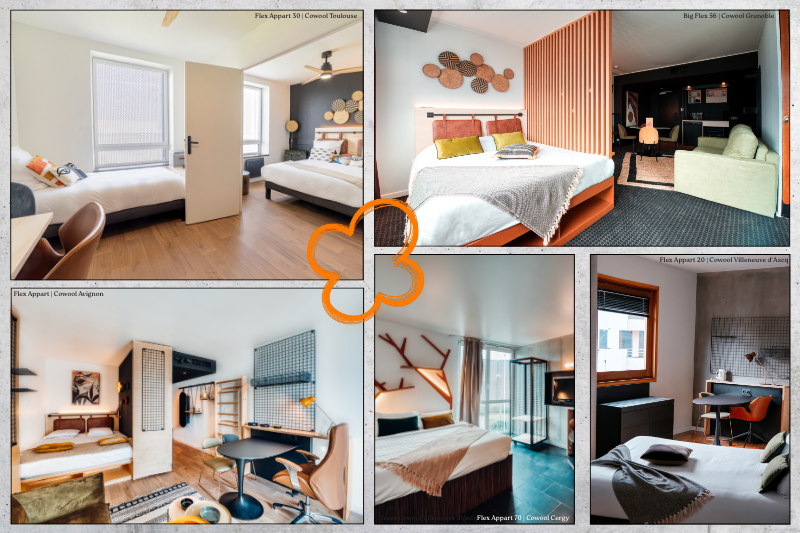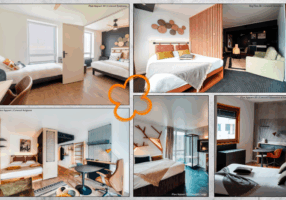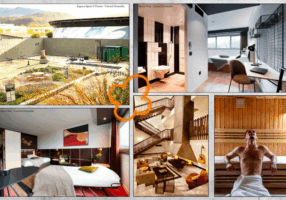

Comment fonctionne le coliving ?

Le coliving : un nouveau mode de vie, entre liberté, partage et confort
Le coliving, c’est bien plus qu’une tendance : c’est un nouveau format de logement.
Chez Cowool, le coliving est un modèle d’hébergement à mi-chemin entre la colocation, l’appartement meublé, l’hôtel, et l’espace de coworking. En fait, c’est un peu tout ça en même temps. Et c’est surtout offrir un lieu de vie convivial, modulable et ouvert, conçu pour ceux qui cherchent à vivre autrement.
Le concept : un chez-soi, des espaces partagés et une vraie communauté
Dans une résidence de coliving Cowool, chaque résident dispose d’un espace privé tout équipé – studio avec salle de bain et kitchenette – et accède à de nombreux espaces partagés pour travailler, cuisiner, se détendre, échanger ou créer du lien.
Vous pouvez retrouver ces espaces dans nos résidences : salon partagé, cuisine commune, espace de coworking, salle de sport, salle de jeux, jardin ou terrasse, bibliothèque, parking, et même une salle de projection video.
La liste peut varier selon les sites Cowool, mais l’idée reste la même : vivre ensemble, avec confort et liberté.
Un fonctionnement simple et flexible
Cowool casse les codes classiques du logement, avec son offre d’hébergement en coliving dans ses résidences. Pas besoin de s’engager pour un an. Vous pouvez louer un logement à la journée, à la semaine, au mois, ou plus si affinités.
Chaque formule est “all inclusive” : vous payez un loyer unique qui couvre le logement, l’électricité, le chauffage, l’eau, l’internet, l’assurance habitation, l’entretien… et l’accès à tous les services partagés.
Finies les démarches compliquées et les abonnements multiples. Vous arrivez, tout est prêt. Un peu comme à l’hôtel, mais en mieux, parce qu’ici vous êtes chez vous.
Vivre ensemble, sans étouffer
Chez Cowool, vous gardez votre intimité tout en choisissant les moments de vie partagés. On vit à côté, pas les uns sur les autres. C’est modulable, selon vos envies : vous pouvez télétravailler au calme dans votre studio équipé, ou vous installer dans l’open space avec d’autres cowoolers. Vous pouvez déjeuner seul, ou partager une soirée jeux ou pizza dans l’open space.
Le coliving chez Cowool, c’est la liberté d’être ensemble, sans obligation.
Travailler, se concentrer, créer
Le coworking fait partie intégrante de l’expérience de coliving Cowool. Chaque résidence dispose en effet d’espaces de travail pensés pour s’adapter à tous les usages : bureaux partagés, cabines de visio, salles de réunion, bureaux individuels… Et avec ceci, les services incluent l’imprimante, le Wi-Fi haut débit et… l’accès machine à café, bien sûr.
Pour qui ? Pour tous ceux qui veulent bouger autrement.
Idéal pour les freelances, les salariés nomades, les étudiants ou les entreprises en déplacement. Certaines entreprises logent même leurs collaborateurs à l’année dans nos résidences.
Le coliving attire une grande diversité de profils : étudiants, jeunes actifs, entrepreneurs, freelances, salariés en mission, voyageurs longue durée, personnes en transition, retraités actifs… Toutes celles et ceux qui ne veulent plus choisir entre confort, lien social et liberté.
C’est le lieu idéal pour vivre seul sans être isolé, dans un environnement chaleureux, stimulant, et ouvert à la rencontre.
Pourquoi choisir le coliving chez Cowool ?
Parce qu’on ne vous propose pas juste un logement, mais une nouvelle façon d’habiter.
Parce que chez nous, tout est flexible : votre logement, votre durée de séjour, votre manière de vivre les espaces.
Parce que tout est durable : gestion intelligente des ressources, mutualisation des services, bâtiments optimisés.
Parce que tout est ouvert : à la ville, aux idées, aux autres.
Et parce que chez nous, la vie est aussi ludique : partages, rencontres, événements, espaces chill, tout est fait pour se sentir bien.
✨ Cowool, c’est la maison où tout devient possible.
Combien ça coûte ?
Les loyers varient en fonction de la ville, des services proposés et de la taille de l’espace privé.
Mais attention, ce n’est pas comparable à une simple location : ici, tout est inclus, tout est prêt, et vous vivez bien plus que dans un simple “appart”. Charges comprises, pas de frais de dossier, pas de garant, laverie et parking sur place, surveillance de la résidence, domiciliation, réception de vos colis, accès libre à la salle de sport, la salle de gaming ou la salle cinéma… tout ça, ça n’a pas de prix.
Où nous trouver ?
Les résidences Cowool sont implantées dans des villes dynamiques comme Avignon, Cergy, Grenoble, Villeneuve-d’Ascq, Toulouse, Compiègne, et bientôt dans bien d’autres. À chaque fois, nous adaptons le lieu à l’environnement local, avec toujours la même vision : un cadre de vie évolutif et chaleureux, pour des citadins en mouvement.
Le coliving Cowool, ce n’est pas juste un lieu. C’est un état d’esprit.
Vous cherchez un logement sans prise de tête ? Un lieu où vivre, travailler et rencontrer ? Un endroit où vous sentir libre mais entouré ?
Chez Cowool, on vous accueille comme chez vous, que ce soit pour quelques jours ou plusieurs mois.
Bienvenue chez Cowool.
Résidences
Découvrir plus ...
Les Coworkers témoignent
Travailler autrement, nos Coworkers en parlent mieux que nous. Chez Cowool, nous croyons qu’un espace de travail doit être plus qu’un simple bureau : un lieu vivant, modulable et inspirant.Chaque jour, nos coworkers investissent nos open spaces, nos salles de réunion et nos bulles de concentration, pour travailler librement, échanger,…
Nos Cowoolers en parlent
Qui mieux que nos Cowoolers pour raconter l’expérience Cowool ? Chez Cowool, nous construisons des lieux de vie et de travail pensés pour la liberté, le partage et l’inspiration. Mais finalement, ce sont celles et ceux qui vivent l’expérience chaque jour qui en parlent le mieux. Découvrez ce que nos…
Découvrir le coworking : une nouvelle façon de vivre le travail
Ici, on travaille sérieusement, mais sans routine imposée. Un lieu ouvert, vivant, où l’on avance à son rythme et où chaque journée peut prendre une autre forme. Le coworking, ce n’est pas seulement une autre manière de poser son ordinateur. C’est une réponse aux envies de liberté, de souplesse et…
Des services, qui font vivre autrement
Chez Cowool, vivre, travailler et se détendre ne font qu’un. Découvrez nos services pensés pour un quotidien libre, convivial et toujours un peu décalé. Chez Cowool, on ne vit pas juste quelque part. On explore, on partage, on respire, on crée. Et pour que chaque moment ait sa place, on…
Découvrir le coliving : le confort d’un chez-soi
Le coliving, c’est bien plus qu’un concept. C’est une nouvelle façon d’habiter la ville, de se sentir chez soi, ensemble, sans compromis. Chez Cowool, on a une conviction : la vie en ville peut être douce, simple et humaine.Alors on a imaginé des lieux de vie hybrides, où l’on peut…
Nos équipes, ces héros discrets qui font vibrer nos lieux
Cowool, c’est plus qu’un lieu, c’est une énergie portée par ses équipes. Chez Cowool, nous ne créons pas simplement des espaces de coworking ou de coliving. Nous réinventons la vie en ville en proposant des lieux modulables, ouverts, durables et ludiques, où travail, détente et vie sociale cohabitent naturellement. Chaque…
Coworking, pour quelles activités ?
Travailler autrement, dans un lieu qui vous ressemble. C’est ça, l’idée. Chez Cowool, le coworking n’est pas un service en plus. C’est un état d’esprit. Une nouvelle façon de vivre le travail, plus libre, plus souple, plus humaine. Et surtout : plus en phase avec la réalité d’aujourd’hui. Un bureau…
Le travail en coworking, une tendance qui séduit !
Le mode de travail en coworking n’est plus un effet de mode. C’est un mouvement de fond. Une manière de travailler plus libre, plus humaine, plus vivante. Fini le bureau fermé sur lui-même, la routine 9h-18h dans le même décor, les silences pesants dans un open space sans âme. Le…
Vivre en coliving à Grenoble : la montagne, l’équipe, la liberté
Le coliving à Grenoble, un mode de logement qui plait à tous Certaines villes vous accueillent avec une poignée de main. Tandis que d’autres vous ouvrent les bras. Et Grenoble fait clairement partie de la deuxième catégorie. Entourée de montagnes et remplie de bonnes ondes, c’est en effet une ville…
Bienvenue dans l’univers du flex office !
Flex office : et si travailler ne rimait plus avec s’enfermer ? Bienvenue dans le monde du Flex office ! Celui dans lequel vous choisissez comment, où et quand travailler. Un monde où la flexibilité n’est pas un bonus, mais une base. Un monde ouvert, modulable, inspirant. Où l’espace de…
Apprtement Bureaux & Coworking Séminaires
vivre, rire, dormir, bosser,
jouer, partager













